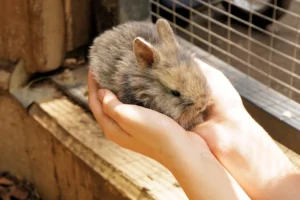Do you ever wonder if rabbits quench their thirst in the wild? Well, the answer may surprise you!
In their natural habitat, rabbits do indeed drink water to stay hydrated. This article will delve into the intriguing world of wild rabbit water consumption, exploring their diet, water sources, and fascinating adaptations.
So, if you’re curious about how these furry creatures satisfy their thirst in the great outdoors, keep reading to uncover the secrets of wild rabbit hydration!
In This Article
- 1 Key Takeaways
- 2 Wild Rabbit Diet: Understanding the Basics
- 3 Water Sources in the Natural Habitat
- 4 Hydration Needs of Wild Rabbits
- 5 Factors Affecting Water Intake
- 6 Water Conservation Strategies in the Wild
- 7 Adaptations for Obtaining Water
- 8 Observations and Studies on Wild Rabbit Drinking Behavior
- 9 Frequently Asked Questions
- 9.1 Can Wild Rabbits Survive Without Drinking Water?
- 9.2 How Do Wild Rabbits Find Water Sources in Their Natural Habitat?
- 9.3 Do Wild Rabbits Have Specific Hydration Needs?
- 9.4 What Factors Can Affect the Water Intake of Wild Rabbits?
- 9.5 Are There Any Specific Adaptations That Wild Rabbits Have for Obtaining Water in the Wild?
Key Takeaways
- Wild rabbits rely on foraging habits to find grasses, shrubs, and tree bark for their water needs.
- Water availability from streams, ponds, and rainfall is crucial for the overall health and well-being of wild rabbits.
- Rabbits have evolved to locate and access water sources, including dew and rainwater collected on leaves and grass blades.
- Providing access to fresh and clean water sources is important for the hydration of wild rabbits.
Wild Rabbit Diet: Understanding the Basics
You should always consider the basics when understanding a wild rabbit’s diet.
It’s important to know that rabbits have a unique digestive system that allows them to efficiently process plant material. Their digestive system is designed to extract nutrients from high-fiber foods, such as grasses, leaves, and twigs.
Rabbits have a specialized chamber in their digestive tract called the cecum, where bacteria break down the cellulose in these plant materials. This process allows rabbits to obtain essential nutrients from a primarily herbivorous diet.
In the wild, rabbits rely heavily on foraging habits to find a variety of vegetation to meet their nutritional needs. They spend a significant amount of time searching for food, which includes grasses, shrubs, and even tree bark.
Understanding the rabbit’s digestive system and foraging habits is crucial in providing them with a balanced and appropriate diet in captivity.
Water Sources in the Natural Habitat
There are various water sources available for rabbits in their natural habitat, such as streams, ponds, and rainfall. These sources provide rabbits with the hydration they need to survive. Water availability is crucial for their overall health and well-being. In the wild, rabbits have evolved to obtain water from these natural sources, adapting to their environment. Let’s take a closer look at the different water sources commonly found in the natural habitat of rabbits:
| Water Sources | Description |
|---|---|
| Streams | Flowing bodies of water |
| Ponds | Small bodies of still water |
| Rainfall | Precipitation from the sky |
Rabbits have the ability to locate and access these water sources, ensuring their survival in their natural habitat. It is important to understand the significance of water availability in supporting the needs of rabbits and to provide them with adequate water in captivity as well.
Hydration Needs of Wild Rabbits
The hydration needs of wild rabbits can be met through various natural water sources, such as streams and ponds. Wild rabbits have developed survival strategies to ensure their water consumption in their natural habitats.
These small mammals have adapted to obtain water from their food sources, such as plants and grasses, which contain a significant amount of moisture. They also rely on dew and rainwater that collect on leaves and grass blades. Additionally, wild rabbits have the ability to conserve water by producing concentrated urine and minimizing water loss through feces.
Understanding the wild rabbit’s water consumption is crucial in serving their needs. Providing access to fresh and clean water sources, like artificial watering stations, can help ensure their hydration and overall well-being.
Factors Affecting Water Intake
Understanding the factors that affect water intake is crucial in ensuring the hydration needs of wild rabbits are met. Rabbits, like all animals, rely on water for their survival and well-being.
Factors influencing hydration in wild rabbits include:
- Availability of water sources: The presence of accessible water plays a significant role in a rabbit’s water intake. Rabbits will seek out water sources such as streams, ponds, or rainfall to quench their thirst.
- Environmental conditions: The weather and temperature can impact a rabbit’s water intake. During hot and dry periods, rabbits may require more water to stay hydrated and regulate their body temperature.
- Diet composition: The type of food rabbits consume can affect their water intake. High-fiber diets, which are essential for their digestive health, require more water to aid in digestion.
Water Conservation Strategies in the Wild
You can implement effective water conservation strategies in the wild to ensure the survival and well-being of wild animals. Water scarcity is a pressing issue that affects many species, and adopting these strategies can help mitigate its impact. Here are some practical ways to conserve water in the wild:
| Strategy | Description |
|---|---|
| Collecting Rainwater | Set up rainwater collection systems to capture and store rainwater for later use by wildlife. |
| Creating Watering Holes | Dig shallow depressions or small ponds to provide a reliable water source for animals in need. |
| Planting Native Vegetation | Choose native plants that require less water and help maintain the natural water cycle in the area. |
Adaptations for Obtaining Water
There are various adaptations that animals have developed in order to obtain water in their natural habitats. These water acquisition methods are essential for their survival strategies. Here are three examples of adaptations seen in animals:
- Camels: Camels have the ability to store large amounts of water in their humps. This adaptation allows them to survive in arid environments for extended periods of time.
- Kangaroo Rats: Kangaroo rats obtain water from the food they eat. They’ve specialized kidneys that allow them to extract water from seeds, minimizing their need for external water sources.
- Desert Tortoises: Desert tortoises are able to obtain water by absorbing it through their cloaca, a vent-like opening. This adaptation helps them conserve water and survive in their dry desert habitats.
These adaptations showcase the incredible ways in which animals have evolved to acquire water, ensuring their survival in challenging environments.
Observations and Studies on Wild Rabbit Drinking Behavior
Have you noticed how often wild rabbits drink water in their natural habitats? Wild rabbit water consumption is an important aspect of their survival. These small mammals have developed behavioral adaptations to ensure they meet their hydration needs.
Observations and studies on wild rabbit drinking behavior have revealed interesting findings. Rabbits rely on external water sources such as streams, ponds, or even dew on plants. They’re known to consume water early in the morning and during the evening when temperatures are cooler. This behavior helps them avoid excessive heat and dehydration.
Additionally, rabbits have the ability to extract moisture from their food, reducing their dependency on water sources. Understanding wild rabbit water consumption and their behavioral adaptations is crucial in providing appropriate care and support for these animals in their natural environments.
Frequently Asked Questions
Can Wild Rabbits Survive Without Drinking Water?
Without water, wild rabbits cannot survive. They rely on natural sources for hydration. It is crucial for their survival, as water is essential for their bodily functions and maintaining overall health.
How Do Wild Rabbits Find Water Sources in Their Natural Habitat?
Wild rabbits in their natural habitat find water sources through their keen sense of smell. They can detect underground water reserves and also rely on dew and moisture from plants. Water availability is crucial for their survival.
Do Wild Rabbits Have Specific Hydration Needs?
Wild rabbits, like all living creatures, have specific hydration needs. They seek out preferred water sources in their natural habitat and have water conservation mechanisms to ensure their survival in the wild.
What Factors Can Affect the Water Intake of Wild Rabbits?
Factors influencing wild rabbit water intake include climate, food availability, and activity level. Water is essential for their survival, aiding in digestion and maintaining hydration. Ensuring access to clean water is crucial for their overall health and well-being.
Are There Any Specific Adaptations That Wild Rabbits Have for Obtaining Water in the Wild?
Wild rabbits in the wild have remarkable adaptations for obtaining water. Their drinking habits are fascinating to observe. You’ll be astonished by the ingenious ways they quench their thirst and survive in their natural habitat.





